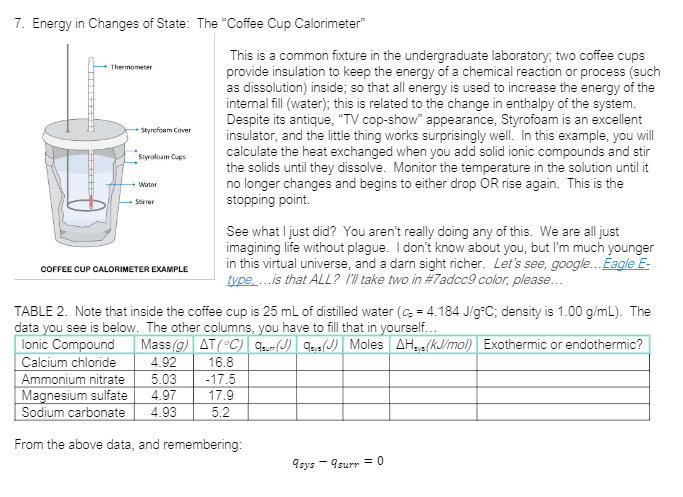TABLE 2. Note that inside the coffee cup is 25 mL of distilled water (cp = 4.184 J/goC; density is 1.00 g/mL). The data you see is below. The other columns, you have to fill that in yourself... Iconic Compound Mass(g) T(celsius) qsurr(J) qsys(J) Moles Hsys(KJ/mol) Exothermic or endothermic? Calcium Chloride 4.92 16.8 Ammonium nitrate 5.03 -17.5 Magnesium Sulfate 4.97 17.9 Sodium Carbonate 4.93 5.2
TABLE 2. Note that inside the coffee cup is 25 mL of distilled water (cp = 4.184 J/goC; density is 1.00 g/mL). The data you see is below. The other columns, you have to fill that in yourself... Iconic Compound Mass(g) T(celsius) qsurr(J) qsys(J) Moles Hsys(KJ/mol) Exothermic or endothermic? Calcium Chloride 4.92 16.8 Ammonium nitrate 5.03 -17.5 Magnesium Sulfate 4.97 17.9 Sodium Carbonate 4.93 5.2
Chemistry by OpenStax (2015-05-04)
1st Edition
ISBN:9781938168390
Author:Klaus Theopold, Richard H Langley, Paul Flowers, William R. Robinson, Mark Blaser
Publisher:Klaus Theopold, Richard H Langley, Paul Flowers, William R. Robinson, Mark Blaser
Chapter5: Thermochemistry
Section: Chapter Questions
Problem 80E: Ethanol, C2H5OH, is used as a fuel for motor vehicles, particularly in Brazil. (a) Write the...
Related questions
Question
TABLE 2. Note that inside the coffee cup is 25 mL of distilled water (cp = 4.184 J/goC; density is 1.00 g/mL). The data you see is below. The other columns, you have to fill that in yourself...
| Iconic Compound | Mass(g) | T(celsius) | qsurr(J) | qsys(J) | Moles | Hsys(KJ/mol) | Exothermic or endothermic? |
| Calcium Chloride | 4.92 | 16.8 | |||||
| Ammonium nitrate | 5.03 | -17.5 | |||||
| Magnesium Sulfate | 4.97 | 17.9 | |||||
| Sodium Carbonate | 4.93 | 5.2 |

Transcribed Image Text:7. Energy in Changes of State: The "Coffee Cup Calorimeter"
This is a common fixture in the undergraduate laboratory; two cffee cups
provide insulation to keep the energy of a chemical reaction or process (such
as dissolution) inside; so that all energy is used to increase the energy of the
internal fill (water); this is related to the change in enthalpy of the system.
Despite its antique, "TV cop-show" appearance, Styrofoam is an excellent
insulator, and the little thing works surprisingly well. In this example, you will
calculate the heat exchanged when you add solid ionic compounds and stir
the solids until they dissolve. Monitor the temperature in the solution until it
no longer changes and begins to either drop OR rise again. This is the
stopping point.
Thermometer
Styrofoem Cover
Styroloam Cups
Water
Stirrer
See what I just did? You aren't really doing any of this. We are all just
imagining life without plague. I don't know about you, but I'm much younger
in this virtual universe, and a darn sight richer. Let's see, google. Eagle E-
type.is that ALL? 'll take two in #7adcc9 color, please.
COFFEE CUP CALORIMETER EXAMPLE
TABLE 2. Note that inside the coffee cup is 25 ml of distilled water (c = 4.184 Jig°C; density is 1.00 g/mL). The
data you see is below. The other columns, you have to fill that in yourself..
lonic Compound
Calcium chloride
Ammonium nitrate
Magnesium sulfate
Sodium carbonate
Mass (g) AT(°C) C() 9,(J) Moles AH, (kJ/mol) Exothermic or endothermic?
4.92
16.8
5.03
4.97
-17.5
17.9
4.93
5.2
From the above data, and remembering:
9sys
- Asurr = 0
Expert Solution
This question has been solved!
Explore an expertly crafted, step-by-step solution for a thorough understanding of key concepts.
This is a popular solution!
Trending now
This is a popular solution!
Step by step
Solved in 5 steps

Knowledge Booster
Learn more about
Need a deep-dive on the concept behind this application? Look no further. Learn more about this topic, chemistry and related others by exploring similar questions and additional content below.Recommended textbooks for you

Chemistry by OpenStax (2015-05-04)
Chemistry
ISBN:
9781938168390
Author:
Klaus Theopold, Richard H Langley, Paul Flowers, William R. Robinson, Mark Blaser
Publisher:
OpenStax

Chemistry: Principles and Practice
Chemistry
ISBN:
9780534420123
Author:
Daniel L. Reger, Scott R. Goode, David W. Ball, Edward Mercer
Publisher:
Cengage Learning

Chemistry for Engineering Students
Chemistry
ISBN:
9781337398909
Author:
Lawrence S. Brown, Tom Holme
Publisher:
Cengage Learning

Chemistry by OpenStax (2015-05-04)
Chemistry
ISBN:
9781938168390
Author:
Klaus Theopold, Richard H Langley, Paul Flowers, William R. Robinson, Mark Blaser
Publisher:
OpenStax

Chemistry: Principles and Practice
Chemistry
ISBN:
9780534420123
Author:
Daniel L. Reger, Scott R. Goode, David W. Ball, Edward Mercer
Publisher:
Cengage Learning

Chemistry for Engineering Students
Chemistry
ISBN:
9781337398909
Author:
Lawrence S. Brown, Tom Holme
Publisher:
Cengage Learning

Principles of Modern Chemistry
Chemistry
ISBN:
9781305079113
Author:
David W. Oxtoby, H. Pat Gillis, Laurie J. Butler
Publisher:
Cengage Learning

Chemistry & Chemical Reactivity
Chemistry
ISBN:
9781133949640
Author:
John C. Kotz, Paul M. Treichel, John Townsend, David Treichel
Publisher:
Cengage Learning

Chemistry & Chemical Reactivity
Chemistry
ISBN:
9781337399074
Author:
John C. Kotz, Paul M. Treichel, John Townsend, David Treichel
Publisher:
Cengage Learning